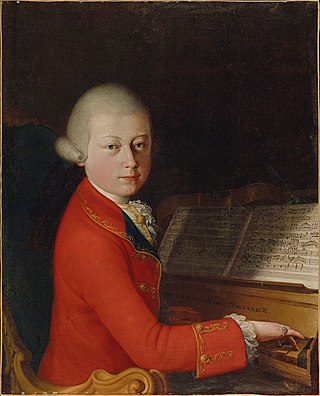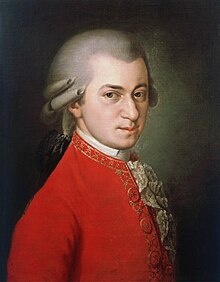
The Symphony No. 25 in G minor, K. 183/173dB, was written by the then 17-year-old Wolfgang Amadeus Mozart in October 1773, shortly after the success of his opera seria Lucio Silla. It was supposedly completed in Salzburg on October 5, a mere two days after the completion of his Symphony No. 24, although this remains unsubstantiated. Its first movement was used as the opening music in Miloš Forman's film biographical Amadeus.

The Symphony No. 5 in B♭ major, K. 22, was composed by Wolfgang Amadeus Mozart in The Hague in December 1765, at the age of nine, while he was on his musical tour of Western Europe. Mozart fell seriously ill during his stay in The Hague, and he wrote this composition probably while he was convalescing from his illness.

The Symphony No. 29 in A major, K. 201/186a, was completed by Wolfgang Amadeus Mozart on 6 April 1774. It is, along with Symphony No. 25, one of his better known early symphonies. Stanley Sadie characterizes it as "a landmark ... personal in tone, indeed perhaps more individual in its combination of an intimate, chamber music style with a still fiery and impulsive manner."

Symphony No. 16 in C major, K. 128, was the first of three symphonies composed by Wolfgang Amadeus Mozart in May 1772 when Mozart was sixteen years old. This symphony is one of many written during the period in which Mozart stayed in Salzburg, between two trips to Italy. The autograph of the score is preserved in the Berlin State Library.

Symphony No. 20 in D major, K. 133, was composed by Wolfgang Amadeus Mozart in July, 1772, when Mozart was sixteen years old. This symphony is one of many written during the period Mozart stayed in Salzburg, between two trips to Italy. Compared to other symphonies Mozart wrote in this period, the scoring is extravagant, featuring two trumpets in addition to the standard oboes, horns, and strings. The key of D major, which is a key often reserved for ceremonial music, is well suited to the presence of these trumpets.

The Symphony No. 28 in C major, K. 200/189k, by Wolfgang Amadeus Mozart is his last piece in the "Salzburg series". The date of composition is uncertain; it probably dates from 17 or 12 November 1774 or 1773.

The Symphony No. 8 in D major,, by Wolfgang Amadeus Mozart is dated December 13, 1768. Mozart wrote the symphony in Vienna, when he was twelve years old, at a time when he and his family were already due to have returned home to Salzburg. In a letter to his friend in Salzburg, Lorenz Hagenauer, Leopold Mozart says of the delay that "we could not bring our affairs to a conclusion earlier, even though I endeavored strenuously to do so." The autograph of the Symphony No. 8 is today preserved in the Staatsbibliothek Preusischer Kulturbesitz in Berlin.

The Symphony No. 26 in E♭ major, K. 184/161a, was written by Wolfgang Amadeus Mozart and completed on March 30, 1773, one month after he returned from his third Italian tour.

Symphony No. 6 in F major, K. 43, was composed by Wolfgang Amadeus Mozart in 1767. According to Alfred Einstein in his 1937 revision of the Köchel catalogue, the symphony was probably begun in Vienna and completed in Olomouc, a Moravian city to which the Mozart family fled to escape a Viennese smallpox epidemic; see Mozart and smallpox.

Symphony No. 7 in D major, K. 45, by Wolfgang Amadeus Mozart, was completed in Vienna in January 1768 after the family's return from a visit to Olomouc and Brno in Moravia. The symphony is in four movements. Its first performance was probably at a private concert. The symphony was reworked to become the overture to Mozart's opera, La finta semplice, K. 51, composed and performed later that year, and the overture itself was subsequently adapted further to create a new symphony, known in the Köchel 1964 (K6) catalogue as K. 46a. The autograph of the score is preserved in the Staatsbibliothek Preusischer Kulturbesitz in Berlin.

Symphony No. 9 in C major, K. 73/75a, by Wolfgang Amadeus Mozart, has an uncertain provenance. The most likely date of its composition appears to be late 1769 or early 1770 during Mozart's first Italian journey, although some authorities have dated it "probably not before early summer 1772". It may have been started in Salzburg, before the first Italian journey began, and completed during the trip.

Symphony No. 12 in G major, K. 110/75b, by Wolfgang Amadeus Mozart, was composed in Salzburg in the summer of 1771. The symphony was apparently prepared in anticipation of Mozart's second Italian journey, which was to take place between August and December 1771. The symphony is in four movements, the opening allegro being the longest movement that Mozart had written to that date. It is the first of a group of works "painted on a larger canvas and achieving a greater individuality than his earlier exuberant pieces".

Symphony No. 13 in F major, K. 112, by Wolfgang Amadeus Mozart, was written in Milan during his second journey to Italy in the autumn of 1771. The symphony is in four movements, the second of which is scored for strings alone. The third movement minuet may have been written earlier, and then incorporated into the symphony—the autograph manuscript shows the minuet copied in Leopold's hand. Nicholas Kenyon describes Symphony No. 13 as the last in "conventional mode"—thereafter "we are in the beginnings of a different world."

The Symphony No. 15 in G major, K. 124 by Wolfgang Amadeus Mozart was written in Salzburg during the first weeks of 1772. A note on the autograph manuscript indicates that it might have been written for a religious occasion, possibly in honour of the new Archbishop of Salzburg. The work is in four movements, the first of which has been described as innovative and "daring", in view of its variations of tempo. The last movement is characterised by good humour and frivolity, with "enough ending jokes to bring the house down".

Symphony No. 11 in D major, K. 84/73q, was at one time considered unquestionably to be the work of Wolfgang Amadeus Mozart. Its status has, however, been challenged, and remains uncertain. It is believed to date from 1770, and may have been written in Milan or Bologna, if it is a genuine Mozart work. An early manuscript from Vienna attributes the work to Wolfgang, but nineteenth-century copies of the score attribute it respectively to Leopold Mozart and to Carl Dittersdorf. Neal Zaslaw writes: "A comparison of the results of two stylistic analyses of the work's first movement with analyses of unquestionably genuine first movements of the period by the three composers suggests that Wolfgang is the most likely of the three to have been the composer of K73q".

Symphony No. 18 in F major, K. 130, was the last of three symphonies composed by Wolfgang Amadeus Mozart in May, 1772, when he was sixteen years old.

Symphony No. 19 in E-flat major, K. 132, is a symphony composed by Wolfgang Amadeus Mozart in July 1772.

Symphony No. 21 in A major, K. 134, is a symphony that was composed by Wolfgang Amadeus Mozart in August 1772.
The Symphony in F major "No. 43", K. 76/42a, was probably written by Wolfgang Amadeus Mozart.
The Symphony in D major "No. 45", K. 95/73n, was probably written by Wolfgang Amadeus Mozart in 1770 in Rome.





